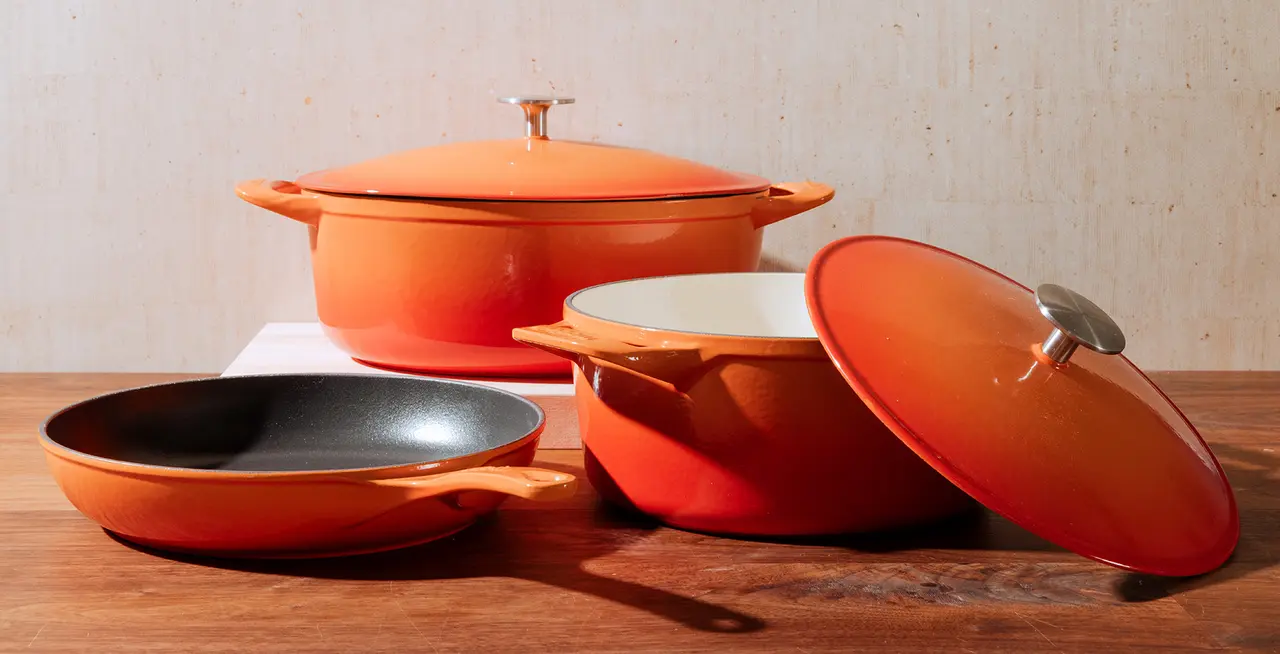Is there anything more iconic in the kitchen than a colorful enameled cast iron? You’ll see the type of cookware in a range of sizes, pots, and styles, from saucepans to Dutch ovens. The material is so popular because it’s sturdy, long-lasting, and also performs incredibly well. Cast iron is renowned for its heat retention capabilities, providing the ideal cooking vessel for stews, soups, breads, braises, beans, and more. You can even deep fry in enameled cast iron pots, or shallow fry in skillets and braisers.
Below, we’ll dive into the pros and cons of enameled cast iron so you’re fully briefed on what to expect before adding this material to your kitchen.
Understanding Enameled Cast Iron

The defining trait of enameled cast iron is—as you may guess—the enamel coating. Enamel coating is made from glass melted under intense heat, creating a non stick cooking surface and also protecting the cast iron from reactive (aka acidic) ingredients that may cause rust or corrosion. This means you don’t need to season the pan before use, and you can also cook acidic ingredients without worry of deteriorating the seasoning.
Most importantly, though, enameled cast iron gives you the best qualities of cooking with unfinished cast iron: even heat distribution and retention. Enameled cast iron typically has a light-colored cooking surface, which makes it easier for you to track how much your food is browning.
Popular cookware pieces made with enameled cast iron include Dutch ovens, braisers, saucepans, and skillets. Our collection is made by multi-generational artisans in Northeast France, where they’ve been pouring cast iron since the 1920s.
Pros of Enameled Cast Iron

We are, as you may guess, huge fans of enameled cast iron. The pros of enameled cast iron include their durability, non-reactive cooking surface, and versatility.
Durability and Longevity
Cast iron can withstand high temperatures and lots of use without wearing down. It will last generations if it’s correctly cared for. (There’s a reason you see so much cast iron in antique shops!) Enameled cast iron comes with its own guidelines for cleaning and care, which we’ve covered in detail.
Non-Reactive Cooking Surface
The enamel coating, applied by hand to ensure even coverage, prevents the iron core from reacting with acidic foods like vinegar, wine, tomatoes, and citrus. That means you can cook a variety of sauces and soups in enameled cast iron without worrying about a metallic taste, discoloration, or eroding the cooking surface or hard-earned seasoning.
Low Maintenance
Unlike traditional (non coated) cast iron, the enamel coating means you don’t need to season your cookware. Since the enamel coating provides a non stick cooking surface, cleaning up is also easier. On the occasion that sticking, discoloration, or burning does happen, though, we've got you covered with how to fix it.
Versatility
You can braise, bake, and slow cook in enameled cast iron, no matter your cooking surface. Cast iron is compatible with gas, electric, and induction. You can also transport it from stovetop to oven—our cast iron is oven safe up to 580F.
Aesthetic Appeal
Perhaps the biggest perk—beyond their versatility, durability, and utility—is the color. Enameled cast iron features a variety of color finishes, making them quite the attractive addition to your kitchen. Their curb appeal means they also work well for serving tableside.
Considerations of Enameled Cast Iron

When choosing if enameled cast iron is right for you, take the following into account.
Heavy Weight
Cast iron is made from pouring molten iron into a mold. While our cast iron is made with compounds that reduce the finished weight of the cookware, it’s still heavier than other materials like carbon steel and stainless steel. Especially with larger pieces like Dutch ovens, this can make them difficult to handle if you struggle with heavy cookware.
Higher Price Point
Enameled cast iron will generally cost more than non-enameled and other types of cookware. But since it lasts for years, that investment may be worth it (and ultimately rounds out to being less expensive than buying cheaper pots and pans more often).
Care Considerations
Enamel coating requires a bit more care than you may be used to. If the coating chips—from rough handling or abrasive cooking tools, for example—then the performance may be affected. Repairing enamel is doable, but it can be expensive.
Slow to Heat
Compared to the super heat conductivity of stainless steel, cast iron takes longer to heat up. (See this in action in our video on cooking eggs, where the enameled cast iron skillet takes 5 minutes versus stainless steel’s 2 ½.) While this may mean you don’t reach for enameled cast iron when you need to quickly cook something, it doesn’t ultimately detract from the cookware’s performance.
Not for High-Heat Dry Cooking
The best way to preserve the enamel is to heat your cookware with oil or liquid. Dry heat—like when making bread in a Dutch oven, or searing ingredients without oil—can damage the enamel over time. Excessive high heat can also cause damage.
Ready to Shop?
Before you decide if it’s right for you, it’s best to understand the pros and cons of enameled cast iron (or any cookware, for that matter). There are so many reasons to love it but there are definitely a few factors that might make you pause, depending on your cooking style. Take a look at our Enameled Cast Iron Collection to see which piece is the best fit for your kitchen.































